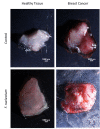Multiphoton Microscopy of FITC-labelled Fusobacterium nucleatum in a Mouse in vivo Model of Breast Cancer
- PMID: 36968439
- PMCID: PMC10031517
- DOI: 10.21769/BioProtoc.4635
Multiphoton Microscopy of FITC-labelled Fusobacterium nucleatum in a Mouse in vivo Model of Breast Cancer
Abstract
Over the past decades, the main techniques used to visualize bacteria in tissue have improved but are still mainly based on indirect recognition of bacteria. Both microscopy and molecular recognition are being improved, but most procedures for bacteria detection in tissue involve extensive damage. Here, we describe a method to visualize bacteria in tissue slices from an in vivo model of breast cancer. This method allows examining trafficking and colonization of fluorescein-5-isothiocyanate (FITC)-stained bacteria in various tissues. The protocol provides direct visualization of fusobacterial colonization in breast cancer tissue. Rather than processing the tissue or confirming bacterial colonization by PCR or culture, the tissue is directly imaged using multiphoton microscopy. This direct visualization protocol causes no damage to the tissue; therefore, all structures can be identified. This method can be combined with others to co-visualize bacteria, types of cells, or protein expression in cells.
Keywords: Bacterial colonization; Breast cancer; Fusobacterium nucleatum; Multiphoton microscopy.
Copyright © 2023 The Authors; exclusive licensee Bio-protocol LLC.
Conflict of interest statement
Competing interestsThe authors declare no competing interests.
Figures


References
-
- Abed J., Maalouf N., Manson A. L., Earl A. M., Parhi L., Emgard J. E. M., Klutstein M., Tayeb S., Almogy G., Atlan K. A., Chaushu S., Israeli E., Mandelboim O., Garrett W. S. and Bachrach G.(2020). Colon Cancer-Associated Fusobacterium nucleatum May Originate From the Oral Cavity and Reach Colon Tumors via the Circulatory System. Front Cell Infect Microbiol 10: 400. - PMC - PubMed
-
- Gonzales-Marin C., Spratt D. A. and Allaker R. P.(2013). Maternal oral origin of Fusobacterium nucleatum in adverse pregnancy outcomes as determined using the 16S-23S rRNA gene intergenic transcribed spacer region. J Med Microbiol 1): 133-144. - PubMed
LinkOut - more resources
Full Text Sources
Miscellaneous

